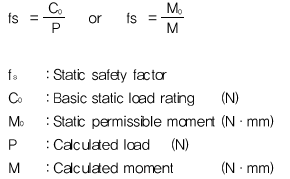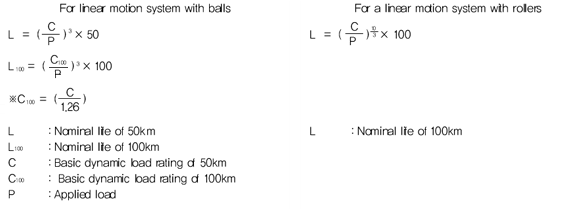-
Structure and Special Feature
-
Load Rating and Service Life Linear Motion System
-
Factors that affect travel life
-
Load Considertion
-
Mean Effective Load at Varying Load
-
SAMICK Support Rail Unit
-
SAMICK LM Shaft
-
SAMICK Shaft Support
-
Self-Aligning Linear Bushing
-
SAMICK LINEAR BUSHING
-
Guide Master
-
Referance Data
> Load Rating and Service Life Linear Motion System
When determine a model that would best suit for service conditions of a linear motion system, the load rating and travel life of the model must be considered. To consider the load rating, you should know the static safety factor of the model, which is calculated based on the basic static load rating. The service life can be assessed by calculating the nominal life, based on the basic dynamic load rating, and you need to check if the values thus obtained meet your requirements.
Basic static load rating
There are two basic load ratings of a linear motion system: basic static load rating (C0), which sets the static load allowance limit, and basic dynamic load rating(C), which is using for calculating travel life.
Basic Static Load Rating (C0)
If a linear motion system, whether at rest or in motion, receives an excessive load or large impact, a local permanent deformation develops the raceway and rolling elements. And if the magnitude of the permanent deformation exceeds a certain limit, it hinders the smooth motion of the linear motion system. The basic static load rating refers to a static load in a given direction with given magnitude, which total permanent deformation of rolling elements and raceway at the contact area is approximately 0.0001 of the rolling element diameter. In a linear motion system, the basic static load rating is defined as the radial load. Thus, the limit of static load allowance is the basic static load rating. For the rating values of individual linear motion systems, see the respective specification table in this catalog.
Static Safety Factor (fs)
A linear motion system may possibly receive an unpredictable external force due to the vibration or impact while it is at rest or in motion, or inertia as a result of starting and stopping. It is, therefore, necessary to consider the static safety factor against operating loads. The static safety factor(fs) indicates the ratio of a linear motion system load carrying capacity (basic static load rating, Co) to the load exerted there on.

To calculate a load exerted on the linear motion system, the mean load for calculating the service life and the maximum load for calculating the static safety factor must be obtained in advance. A system can receive unexpected excessive load when it is subject to frequent starts and stops, placed under machining loads, or when the severe moment is applied by overhanging loads. When selecting the correct type of a linear motion system for your application, be sure that the type you are considering can bear the maximum possible load when stopped and in operation. The table below specifies the standard values for the static safety factors.
| Machine used | Loading conditions | fs lower limit | |
|---|---|---|---|
| Ordinary Industrial Machine | Receives no vibration or impact Receives vibration or impact |
1.0~1.3 2.0~3.0 |
|
| Machone tool | Receives no vibration or impact Receives vibration or impact |
1.0~1.5 2.0 5~7.0 |
|
| For large radial loads |  |
||
 |
|||
Basic Dynamic Load Rating (C)
The basic dynamic load rating (C) refers to a load in a given direction with given magnitude such that when identical linear motion systems in a group are interlocked with one another under the same conditions, the nominal life (L) of the systems is 50km (L=50km) if the systems use balls, and 100km(L=100km) if they use rollers. The basic dynamic load rating (C) is used to calculate the service life of a set of linear motion systems, which are interlocked with one another in response to a load. For rating values of individual linear motion systems, see the respective specification tables in this catalog.
Nominal Life
The service lives of linear motion systems more or less vary from system to system even if they are manufactured to the same specifications and remain in service under the same operating conditions. Hence a guideline for determining the service life of a linear motion system is given based on nominal life, Which is defined as follows. The nominal life refers to the total running distance that 90% of identical linear motion systems in a group, when interlocked with one another under the same conditions, can achieve without flaking develops. The nominal life (L) of a linear motion system can be obtained from the basic dynamic load rating (C) and load imposed (P) using the following equations.

The travel life of the Linear Bushing can be obtained using the following equation

Once nominal life L is obtained using this equation, the Linear Bushing service life can be calculated using the following equation, if the stroke length and the number of reciprocating cycles are constant









